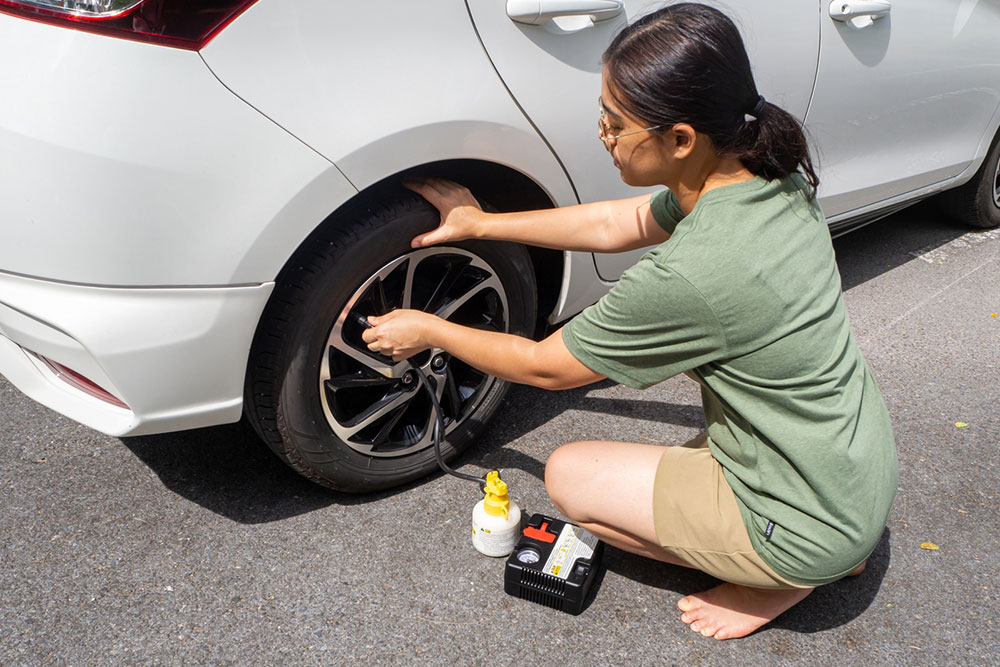Avoid these 9 mistakes while dealing with a flat tire

Those who own a car may find themselves stuck with a flat tire at least once in their lifetime. Changing a tire can be stressful and frustrating, especially if stranded in the middle of nowhere. The situation can get even worse if one makes mistakes while working on a flat tire. Whether a lack of tools or experience, it can eventually lead to prolonged delays and even cancellation of one’s travel plans.
Using the wrong jacking points
Jacking points are reinforced areas of the vehicle’s chassis, generally located behind the front wheels and right in front of the rear wheels. They are designed to safely support the vehicle’s weight while it’s lifted for tire changes or other maintenance tasks. Placing the jack in the wrong position can damage one’s car. In worse cases, the jack could slip from under the vehicle and injure the user. The easiest way to know the correct jacking points is to check the owner’s manual. Since jacks may vary slightly from one vehicle to another, checking the manual can help one understand how to use the tool correctly.
Not using or carrying the tools
Even if it’s a brand new or recently serviced car, one should never leave the house without the tools required for changing a tire. It’s best to have a set permanently stored in the vehicle and, before driving away, check for any missing tools or pieces from the jack kit. Any last-minute left-outs, like wheel nuts and bolts, can prolong the tire-changing process. S ome wheels need a wheel key tool to unlock their nuts, so individuals should ensure they are in place before embarking on a journey. This checkup is important regardless of whether on e is heading out for a long road trip or running an errand nearby .
Carrying a spare tire with inherent issues
Almost all cars come with a spare tire from the manufacturer, but people often forget to maintain it. They unknowingly carry a spare that is unfit for use because of low air pressure or cracks. A ll tires lose their integrity with age, so it’s advised to check for air pressure, cracked rubber, and other damages regularly. If unused for a long time, the spare tire may weaken or develop rotten areas. That’s why it’ s best to check the condition of one’s spare tire, especially if it has been lying aside for a while. Individuals can conduct a check every month or two or while assessing the health of the regular working tires. Doing so ensures the spare is ready for use in an emergency, saving much time and effort.
Working in the middle of the road
While one may face a flat tire issue in the middle of the road, working on it right there is a bad idea. The first thing one should do during a flat tire is pull to the side to ensure road safety. Especially on highways or any traffic-prone areas, it’s best to pull over as soon as possible and turn on the hazard lights so passersby and other drivers know there’s an issue.
Changing a tire on an incline
This is another mistake novice drivers often make. Those driving on an incline should first set the emergency brakes and ensure the car is on level ground before pulling out the jack and fixing the tire. Working on an incline risks the vehicle falling off the jack or destabilizing the car entirely. I f one cannot find level ground, it’s best to place wheel wedges behind or in front of the tires. Doing so will ensure the vehicle won’t roll while replacing a tire.
Overtightening the nuts and studs
Some tend to tighten the wheel nuts or studs too much, thinking it will ensure their safety on the road. This is a big mistake because trying to loosen them by hand later can feel like an uphill battle. Not only that, over-tightening can also mess up the threads on one’s wheels, which can lead to some serious and costly damage down the road.
Not asking passengers to get down
Flat tire situations always require all passengers and pets to vacate the vehicle. This step is necessary because it ensures everyone’s safety, including that of the car . Vacating the vehicle also reduces obstructive pressure on the vehicle and makes tire-changing tasks easier.
Leaving the vehicle in neutral
Those who use a manual gearbox and need to work on a flat tire must always turn off the engine and shift the gearstick into either reverse or first gear. Most hand brakes operate on two wheels, usually the rear ones. P utting the vehicle in reverse or first gear while the engine is off activates the process of locking the front wheels, which are typically the driven wheels on most vehicles. But if one is dealing with a car equipped with an automatic transmission, it’s safe to leave the car in “P” or parking gear.
Using improper gear
Wearing proper gear is essential when changing a flat tire. Sturdy gloves protect the hands from dirt and sharp edges a nd provide a better grip on the tools. Ignoring this step increases the risk of injury during the tire-changing process.







